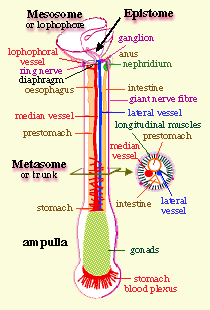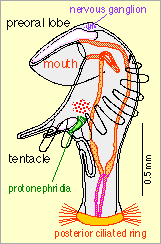|
The Phoronida, also named "horseshoe worms", is an exclusively marine group of lophophorate animals: sedentary infaunal, benthic suspension-feeders, with a vermiform body enclosed in a slender, chitinous tube in which it moves freely and it is anchored by the ampulla, the end-bulb of the body.
The other specific diagnostic features are:
three body parts in larval and adult forms, each containing its own coelom:
- the prosome (with the protocoelom) forms the epistome, a fold extending along the inner row of tentacles and overhanging the mouth dorsally;
- the mesosome (with the mesocoelom) bears mainly the lophophore. The diaphragm, a horizontal septum located behind the lophophore base, separates the protocoelom and mesocoelom from the metacoelom;
- the metasome (or trunk, with the metacoelom) is slender and cylindrical, with a posterior ampulla, which is used to anchor the body at the tube end.
|
a lophophore, which is defined as "a tentacular extension of the mesosome (and of its cavity, the mesocoelom) that embraces the mouth, but not the anus, and its main functions are feeding, respiration and protection" (Hyman, 1959; Emig, 1976). The increasing complexity from an oval towards a helicoidal, through a horseshoe and spiral-shaped lophophore, is related to an increase of the number of tentacles, which is proportional to body size.
a U-shaped digestive tract bringing the anus closes to the mouth. The descending branch is divided into a short oesophagus, a long prestomach, a stomach surrounded by a blood-plexus. A muscular pylorus separates the stomach and intestine, which is a long, slender ascending tube, ending in the anus on the anal papilla.
the nervous system is mainly composed by the nervous ganglion between mouth and anus, a ring nerve at the basis of the lophophore, one or two giant nerves fibres which issue from the ganglion and extend along the body wall at the site of attachment of the lateral mesenteries.
two excretory organs, metanephridia open into the metacoelom by one or two funnels, and discharge to the exterior via a nephridiopore, located on the anal papilla.
The morphological characteristics of the nephridia are of prime taxonomic importance to identify a species.
a closed circulatory system with erythrocytes composed by two longitudinal vessels which communicate through the stomacal blood-plexus and the lophophoral vessel which extends a capillary in each tentacle.
|
|
 Diagram of an adult phoronid
|
|
|
Phoronids are hermaphroditic or dioecious, and also reproduce asexually. Gametes are released through the nephridia, which serve as gonoducts. Fertilisation is internal. Egg cleavage is total, equal, and typically radial.
Three types of developmental patterns occur and lead to a characteristic ciliated and free-swimming larva, the or actinotroch, which has a distinctive appearance larva (see Emig, 1982) . The actinotroch, bearing an anterior preoral lobe on which is located the nervous ganglion (on the apical area), a tentacular ridge, a pair of protonephridia, and posteriorly a ciliated ring around the anus (see Emig, 1982). The larvae undergo a planktotrophic development during 2-3 weeks and settle after about 20 days.
Metamorphosis is "catastrophic", occurring in less than 30 minutes and leading to a slender young phoronid.
|
|
 Diagram of an actinotroch
|
|
|
|
Some general references on phoronids...
Emig C. C., 1976. Le lophophore - structure significative des Lophophorates (Brachiopoda, Bryozoa, Phoronida). Zool. Scripta, 5, 133-137.
Emig C. C., 1979. British and other Phoronids. In : Synopses of the British fauna, Eds Kermack D. M. & R. S. K. Barnes, Acad. Press, London, 13, 57 pp.
Emig C. C., 1982. The biology of Phoronida. Adv. mar. Biol., 19, 1-89.
Emig C. C., 1982. Phoronida. In : Synopsis and classification of Living organisms, Ed. Parker S. P., McGraw-Hill, New-York, vol. 2, p. 741, Pl. 126-127.
Emig C. C., 1982. Bref résumé de quelques connaissances récentes sur les Phoronidiens. Bull. Soc. zool. Fr., 107 (2), 225-232.
Emig C. C., 1983. Phoronida. In : Reproductive Biology of Invertebrates, Eds Adiyodi R. K. & R. G. Adiyodi, Wiley Intersci., New-York, Vol. 1, Oogenesis, oviposition, and oosorption, pp. 535-542.
Emig C. C., 1984. On the origin of the Lophophorates. Z. zool. System. Evolut.-forsch., 22 (2), 91-94.
Emig C. C., 1986. Phylum Phoronida (Horseshoe worms). In : Marine Fauna and Flora of Bermuda, Ed. Sterrer W., Wiley & sons, New-York, pp. 516-518.
Emig C. C. & J. Bailey-Brock, 1987. Phylum Phoronida. In : Reef and Shore fauna of Hawaii, Eds Devaney D. M. and L. G. Eldredge, Sect. 2 & 3: Plathelminthes through Phoronida, and Sipuncula through Annelida, pp. 171-181.
Emig C. C. 1990. Phoronida. In : Reproductive Biology of Invertebrates, Eds Adiyodi R. K. & R. G. Adiyodi, Oxford & IBH, New Dehli, Fertilization, development, and parental care, Vol. 4 (Part B), 165-184.
Corbera J., Emig C. C. & M. Zabala, 1991. Els lofoforats i afins (en catalan), pp. 335-374. Història Natural dels Països Catalans, vol. 8: Invertebrats no artròpodes, 598 pp. Enciclopèdia Catalana, Barcelone.
Emig C. C., 1992. Phoroniden: Bau, Verhalten und Regeneration. In : Meeresbiologische Exkursion. Beobachtung und Experiment. Emschermann, Hoffrichter, Körner & Zissler Eds, Gustav Fischer Verlag, Stuttgart, pp. 156-158.
Balduzzi A. & C. C. Emig, 1995. Lophophorata. In : Check list delle specie della fauna italiana, Minelli A., Ruffo S. & La Posta S. (Eds). Edizioni Calderini, Bologna, 108, 10-23.
Emig C. C. & J.G. Harmelin, 1996. Lophophorates - Bryozoaires, Phoronidiens, Brachiopodes. Encyclopédie Clartés, Editions Clartés, Paris, suppl. 12 (4250), 1-10.
Emig C. C., 1999. Phoronida. In: Embryonic Encyclopedia of Life Sciences. Nature Publishing Group, London, .
|